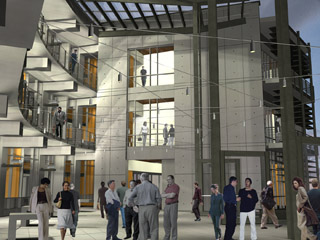|
Subscribe / Renew |
|
|
Contact Us |
|
| ► Subscribe to our Free Weekly Newsletter | |
| home | Welcome, sign in or click here to subscribe. | login |
Construction
| |
 |
May 10, 2012
Concrete cuts costs for UC-San Diego building
The Miller Hull Partnership

Germain
|
The strength and versatility of concrete have made it a popular building component for centuries. Concrete also offers an ingenious, beautiful and cost-effective means to address a range of design and environmental challenges.
For a new engineering building on the University of California, San Diego campus in La Jolla, Calif., using concrete benefits the project in aesthetic, functional and economic ways.
Architectural concrete lends a refined and solid air to the building, offsets impacts of the regional climate, and allows the interior space to be flexible. Estimated cost savings from the use of concrete in this project are in the hundreds of thousands of dollars, making this building an example of why concrete is a smart design choice for today’s contemporary buildings.
Stability and flexibility
The Structural and Materials Engineering Building is an architectural concrete-frame building composed of a rectilinear laboratory wing and a curving wing of offices, conference rooms and communal spaces.
In addition to providing space for engineering and science disciplines, the building also has space for visual arts studies, and is laid out to foster interdisciplinary communication and inspiration across this diverse mix of students and faculty. There is an art gallery and digital presentation “black box” on the main floor, and art studios are on every level, sharing floors with engineering labs and workshop spaces.
Concrete was selected as the structural frame for this massive building primarily because it allows for the structural stability and spatial flexibility required to accommodate a variety of artistic and scientific uses. On a typical day, nanoengineering students may be using sensitive electron microscopes downstairs from the destructive testing of aerospace components in a high bay lab.
The lab block is a conventionally reinforced 12-inch-thick two-way flat slab. The mass of it helps to minimize any unwanted transfer of sound or vibration.
Concrete columns with large angled haunches were developed to eliminate the need for any dropped beams. That kept the ceiling plane clear for required HVAC and lab exhaust, and allowed a reduced floor-to-floor height without the inevitable crossing of large ducts under beams.
During the design process the typical floor-to-floor height was reduced from 16 feet to 14.5 feet, yielding a projected cost savings of $750,000 as the total volume of the building was effectively reduced. Additionally, the simple structural grid and large clear-span spaces allow for future reconfiguration of labs and workshops with minimal impact to the building structure or envelope. This flexibility is important in any building space where needs may change over time.
| Structural and Material Engineering Building |
|
University of California, San Diego (La Jolla, Calif.) Size: 184,000 square feet Construction cost: $63 million Completion: June Architect of record: Miller Hull Partnership Associate architect: Safdie Rabines Architects Structural engineer: Englekirk Structural Engineers General contractor: Mortenson |
The curving office wing uses a more conventional one-way slab over radial beams. A band of faculty offices line the outer curve, and cantilever out over the main building entry and exterior study spaces.
Adjacent to the offices, a large area of open space is built out into shared offices for graduate students. The large primary shear walls are located at the perimeter of the structure, offering architectural expression and allowing for maximum flexibility of the interior space.
Environmentally sound
While the generous use of glass facilitates daylighting and reduced energy costs, the Southern California climate requires strict attention to solar heat gain, and the engineering building was designed with the goal that no direct sun shall touch glass.
The concrete floor slabs cantilever out beyond the recessed storefront windows, combining an expressive architectural element along with primary sun shading. The fact that cantilevered elements made possible by concrete also provide relief from rain make them a practical choice in other climate regions as well.
Additional shading elements, including fixed grating and dynamic exterior blinds, were fine-tuned to provide year-round sun protection.
Concrete is typically considered an environmentally sound building option as it comes from natural materials. In this building, the design team was careful to specify the use of local materials and recycled content in the concrete. The use of concrete also fulfills requirements for the LEED silver certification being sought for the building.
Visual appeal
Concrete has the ability to do double duty as both a structure and a durable, beautiful finish material.
A key design goal was to keep the structure as honest and efficient as possible, considering that many of the end users are structural engineering students and professors learning about the elements of structural design. The success of the design required a true collaborative effort between architects and the structural engineers throughout the design process to manage thicknesses, reveals and construction tolerances.
With no chamfers or “cut” corners, the mix design, including slump and admixtures, played a pivotal role in achieving the final results.
Placement and consolidation techniques, along with adequate rebar coverage, were also critical, resulting in a consistent “as cast” finish requiring little or no sacking, rubbing, polishing or other topical treatments often used to cover or change the appearance of concrete. For visual appeal, all vertical above-grade concrete used type 3 “high early” cement, which contributes to a smoother, more consistent finish — as well as a brighter, whiter color than typical type 2 cements, which generally appear grayer.
In considering concrete as a design option, it is important to consider not only its strength and durability, but to keep in mind that it can add to the aesthetic appeal of the structure, offer environmental benefits, as well as provide significant savings — always a desirable project goal.
Stewart Germain is an architectural designer and project manager with The Miller Hull Partnership.
Other Stories:



